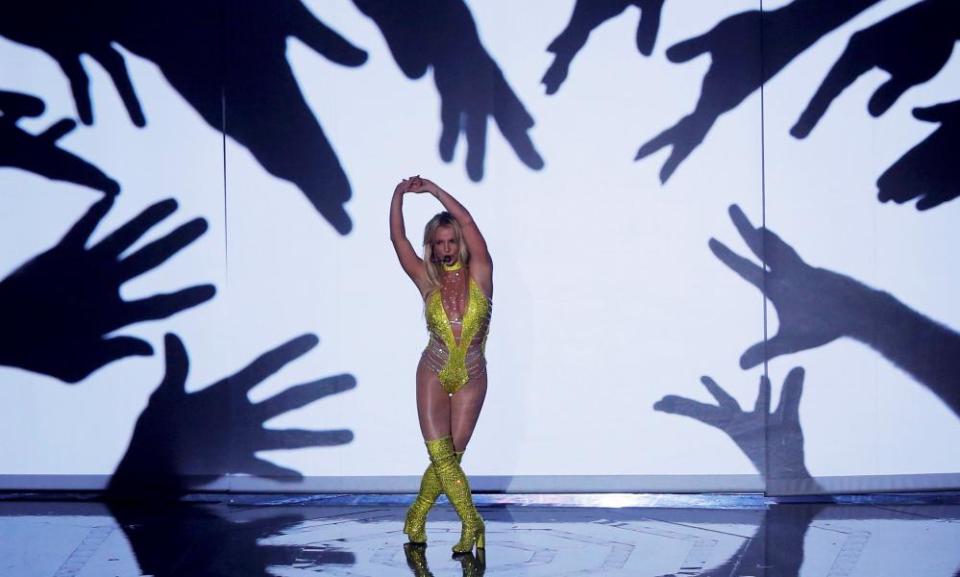Framing Britney Spears exposes the contradictions of American womanhood

- Oops!Something went wrong.Please try again later.
- Oops!Something went wrong.Please try again later.
“It’s something that would not have happened to a man in America,” a blond fan says in the opening moments of Framing Britney Spears, a New York Times documentary about Britney Spears. The woman is talking about Spears’ conservatorship, an elaborate legal arrangement, in place since 2009, in which the singer has been declared unfit to manage her own affairs. The conservatorship means that Spears’ life – and her money – are largely under the control of her father, Jamie Spears, who has been appointed conservator by the court. That arrangement has come under scrutiny as fans speculate that Spears’ independence has been needlessly curtailed by a greedy father and a misogynist court system, and that the singer has been trapped in a literal, court-ordained patriarchy. Spears herself has petitioned for the court appoint a different conservator, saying that she is afraid of her father.
Related: The time has come – I’m joining team #FreeBritney. Here’s why you should, too | Arwa Mahdawi
But really, the fan could be discussing any aspect of Britney Spears’ career. The documentary, nominally pegged to the conservatorship legal battle that has been brewing since 2019, is really an account of Spears’ career, and how she became a symbol for and victim of the media’s misogyny. The film follows Spears from her origins as a talented child in small-town Louisiana, through the height of her fame as a teen pop sensation, and into the mental health crises, legal troubles and slow recovery that have followed. On the way, it confronts an American public all too eager to make a young girl into a symbol for all of its anxieties about sex and womanhood at the dawn of the 21st century.
From the documentary’s telling, Spears was always going to be a star. The film paints a picture of an uncommonly talented young girl, with a quick smile and a powerful singing voice, whose parents are determined to waste neither her gift for performing nor the opportunity that it presented. We see her on Star Search, performing for Ed McMahon as a small child; we see her smilingly presenting on the Mickey Mouse Club as a tween. She signs a record deal with a label in New York and begins performing her first singles in the then ubiquitous shopping malls of the 1990s, as small crowds of shoppers gather. In a grainy archival video, she is a bright, enthusiastic teenager on one of those mall stages, throwing her right hand in the air with a practiced ease in a bit of choreography that’s instantly recognizable: it’s the same gesture she will perform in her 1999 debut music video, Baby One More Time, famously dancing in the halls of a high school in a sexualized parody of a Catholic school uniform. She is 16.
That single rocketed Spears to a kind of fame that few performers ever achieve and that few people would be able to survive. She was at once a person and an industry, becoming the center of a celebrity media apparatus on which thousands depended for their livelihoods and which millions more consumed as their entertainment. From those tender teen years, her body and private life became objects of speculation and scrutiny for anonymous masses of strangers. Particularly, people were interested in her sex life. In archival videos, the documentary shows Spears smiling stiffly at interviewers – most of them men old enough to be her father – asking about various body parts, whether she’s had sex yet, what sort men she would have sex with, if she was having sex. Her breasts, her virginity, her boyfriends, all of these became things that grown men felt entitled to ask her about, and did. And all of these became things that Spears found herself – with forced, patient and practiced cheer – having to answer for.
For all her fame and success, she is not afforded respect
In the documentary’s footage, virtually none of the interviewers seem to be approaching Spears with deference or kindness. There’s a condescension and disrespect in their questions that make it clear that they very much feel themselves to be talking to a silly young girl, even as the content of their conversations veers decidedly into the adult. For all her fame and success, she is not afforded respect. The dissonance underscores all the contradictions in the American notion of womanhood that Spears had been tasked with fulfilling: she was depicted as famous yet simple, rich yet bumpkinish, personally virginal yet capable of performing aggressive sexuality, warm, familiar and accessible, yet impossibly famous and set apart. In the interviews, you can almost see her calculating how to maintain this balance, the stress of all the oppositions flickering in her huge brown eyes.
What men in the entertainment industry didn’t realize – or maybe willfully ignored – is that femininity like Spears’ is not a natural, unconscious inclination for the women who practice it. Instead, it is a set of skills. To become the performer and media figure that she was, Spears had to have a meticulous understanding of interpersonal relationships and public relations; of music and dance; of fitness and metabolism; of flattery, appeasement and conflict de-escalation.
All women have these skills to some degree; Spears had to deploy them in spades. She learned early: when McMahon asks the young Spears, a contestant on Star Search, whether she has a boyfriend, she deflects, explaining that boys are mean. When McMahon counters that he is a boy and he is not mean, she gamely reassures him. She is maybe 10 years old. When a foreign interviewer asks about her breasts and she winces, the journalist points out that she is uncomfortable, delighted in his power to disturb her; she quickly collects herself and disposes with his question with a good natured smile. She appears to be in her teens. We like to interpret these gestures of social grace, generosity, or deliberate, polite misunderstanding as women’s unconscious instincts. In fact, they are willful performances, ones that require effort to make and maintain. This blindness allowed many in the media – and many who consumed it – to see Britney Spears as a silly girl, saying girlish things and indulging in girlish vanities, rather than as a woman under impossible pressure, working as hard as she can.
The efforts required to maintain her acceptable public femininity accumulated over days and months and years. At a certain point, Spears ran out of the patience and energy that they required. For years Spears had achieved the impossible, maintaining the performance of acceptable, welcoming, nonthreatening femininity in front of an demanding audience, seeming to maintain all of American womanhood’s contradictions and all of American manhood’s anxieties about women with ease. But it was not easy. The effort broke her.

The turn came, as it so often does, when she disappointed a man. Britney Spears’ relationship with Justin Timberlake was an almost-too-perfect culmination of both of their teen pop careers. They attended awards shows, graced magazine covers together and projected an aura of rigorously wholesome happiness. But when they broke up in 2002, Timberlake weaponized his fame in the service of his resentment. In the media, he strongly implied that she had cheated on him; he bragged on the radio about taking her virginity. The music video for Timberlake’s single Cry Me A River dramatized his version of their relationship: a Spears stand in charms and seduces the Timberlake character, who sings in a rainstorm. But when she thinks he can’t see, she betrays him with another man. In this telling, Spears’ performance of feminine charm is not a valuable and well-practiced skill, but a tool of deception.
Things went downhill from there. The documentary follows Spears as she navigates a judgmental press and a physically aggressive paparazzi. She marries the backup dancer Kevin Federline and gives birth to her first son, and the topics of media condemnation expand, from her sexuality to her marriage and motherhood. In the interviews from the mid-aughts, Spears seems tired, frustrated, and confused. She still has her charm, but the demands of the press are greater, the stakes higher. In an interview with Matt Lauer, the then NBC anchor who was later disgraced in a sexual misconduct scandal, a pregnant Spears chews gum, her veneer of patience cracking. “You saw the questions that were being asked,” Lauer said, gesturing at Spears with the tip of a pen. “‘Is Britney a bad mom?’” “Mmm-hmm,” the singer replies, rolling her gum pointedly from one side of her mouth to the other. “That’s America for you.”
The scrutiny had grated on her patience, and on her self esteem. She experienced postpartum depression, and turned to drugs and alcohol for solace. Her marriage and her psyche unraveled, both in full public view. Famously, she shaved her head – maybe to avoid the drug testing that was part of an ongoing custody battle with Federline, maybe also to rid herself of the femininity whose promises had turned into punishments. She attacked a paparazzo’s car with an umbrella, leaving dents in the side. She was in and out of rehab. Not long after is when the conservatorship began.
Reframing Britney means to indict a misogynist media, but it also raises the question of what is to be done with female talent in a ferociously sexist world. The documentary paints Spears’ father as a villain who subjected her to the abuse of fame for his own profit, and indeed Jaime Spears does come off as a man with many demons and few scruples. But it’s clear that Spears had a real talent and enthusiasm for performing, even from a young age; its clear, too, that any young woman who became that famous would have been treated that badly. We will likely never know how many women were stopped or deterred from careers in public life by the treatment that Spears and other women in public experience. When does scrutiny become abuse, and when does abuse become a condition of public life? What have we lost by making sexist hostility a prerequisite for women’s public pursuit of their own talents?
For her part, Spears has embarked on a long, slow process of mental and emotional recovery in the years since her public decline. She has a residency in Las Vegas; she has regained custody of her kids. She is private – a hard-earned and understandable stance – but her life appears quiet and peaceful. Against the odds, Spears appears to be regaining that quality that she was once so ferociously denied: dignity.

